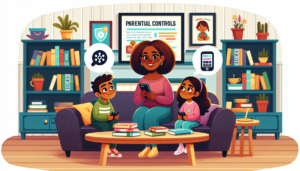Key Takeaways
| Aspect | Takeaway |
|---|---|
| Online Safety Education | Understand the apps and platforms children use. |
| Open Communication | Regularly discuss online activities with your children. |
| Privacy Awareness | Teach kids about online privacy and data sharing. |
| Utilizing Controls | Use parental controls to manage and monitor online access. |
In the realm of digital communication, staying informed is not just an advantage – it’s a necessity for parents. With children now native to the online world, the task of keeping them safe and responsible falls significantly on how well parents can navigate and understand the intricacies of the web.
Building Digital Literacy
For parents, digital literacy is more than a buzzword; it’s an essential skill. The internet is a vast ocean, and understanding the currents – from the latest social media platforms to the newest messaging apps – can make the difference in keeping your children safe. But it’s not just about safety. It’s also about connection. Being familiar with Safe Lagoon’s instant message monitoring can be a gateway to understanding your child’s online world.
Fostering Open Dialogues
Communication is the bridge that connects you to your child’s digital experience. It’s important to foster an environment where your children feel comfortable sharing their online encounters. This transparency is pivotal in guiding them through their digital journey and is enhanced by tools that promote healthy usage, like Safe Lagoon’s screen time management.
Teaching Privacy and Security
In the digital age, privacy should be treated as both a skill and a value. Educating your children about the importance of maintaining privacy online – and the potential consequences of not doing so – is critical. Discuss the permanence of online actions and the importance of safeguarding personal information.
Implementing Parental Controls
Parental controls are not about limiting freedom; they’re about enabling safe exploration. With solutions like Safe Lagoon, parents can guide their children’s online activities without stifling their independence. It’s about creating a balanced approach where children learn to use the internet responsibly.
Are You Ready to Dive In?
It’s essential to ask yourself if you’re ready to take an active role in your child’s online life. Being involved means more than just setting rules; it’s about engaging with your child’s digital interests and concerns. Safe Lagoon is here to support you on this journey, providing a suite of features to ensure your peace of mind.
For more detailed insights on online safety and digital parenting, check out our blog. Ready to take the first step in becoming a digital-savvy parent? Download Safe Lagoon today and join a community of proactive parents.





